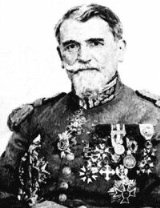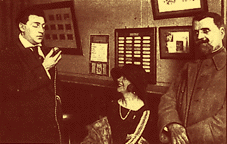
Gustave-Auguste Ferrié
Encyclopedia
Gustave-Auguste Ferrié was a French
radio
pioneer and army general.

, Savoie
. After having studied in Draguignan
, received the Claude Gay
Prize, and graduated from the École Polytechnique
, Paris
, in 1891, he became an officer in the French army's Engineers Corps, specializing in its military telegraph service. After being named to a committee exploring wireless telegraphy
between France
and England
, in 1899 he carried out such communications in collaboration with Guglielmo Marconi
.
He exposed his works on August 22, 1900, when the International congress of electricity was organized in Paris. His works had the title : “L'état actuel et les progès de la télégraphie sans fil” (Actual knowledge and progress of no-wired telegraphy).
In 1903 Ferrié invented a novel electrolytic detector
, invented independently by Dr. Michael I. Pupin (1899), Professor Reginald A. Fessenden (1903), and W. Schloemilch (1903). That same year he also proposed setting antennas on the Eiffel Tower
for long-range radiotelegraphy. Under his direction a transmitter was set up in the tower, and its effective range increased from an initial 400 km (248.5 mi) to 6000 km (3,728.2 mi) by 1908. He then developed mobile transmitters for military units.
Ferrié headed the French Radiotelegraphie Militaire before and during World War I
, where in 1914 he led two linked advances in military radio communications : practical ground telegraphy made feasible by the adoption of vacuum tube
s within radio receivers. The transmitter was a buzzer, and the receiver an amplifier
with triode
. By war's end the French had produced almost 10,000 such sets.
Ferrié was made a General in 1919 and so remained until his death, having been exempted from retirement rules by a special law of 1930, and became general inspector of military telegraphy.
Ferrié was named a Fellow of the Institute of Radio Engineers
in 1917, and in 1931 received its Medal of Honor
for "his pioneer work in the upbuilding of radio communication in France and in the world, his long continued leadership in the communication field, and his outstanding contributions to the organization of international cooperation in radio." He received on honorary doctorate from Oxford University in 1919, and in 1922 became a member of the French Academy of Sciences
. He was the first president of the French National Committee of Geodesy and Géophysique (1920–1926), president of the International Scientific Radio Union (U.R.S.I.) and the International Commission on Longitudes by Radio, and vice president of the International Board of Scientific Unions.
Ferrié died on February 16, 1932, at the Val-du-Grâce military hospital in Paris. Several hours after his death he was awarded the Grand Cross of the Legion of Honor.
Today the Espace Ferrié (Musée des Transmissions) continues his memory in Cesson-Sévigné
. A college named "collège Ferrié" is located in Draguignan
and in the 10th district of Paris
.
France
The French Republic , The French Republic , The French Republic , (commonly known as France , is a unitary semi-presidential republic in Western Europe with several overseas territories and islands located on other continents and in the Indian, Pacific, and Atlantic oceans. Metropolitan France...
radio
Radio
Radio is the transmission of signals through free space by modulation of electromagnetic waves with frequencies below those of visible light. Electromagnetic radiation travels by means of oscillating electromagnetic fields that pass through the air and the vacuum of space...
pioneer and army general.

Biography
Ferrié was born in Saint-Michel-de-MaurienneSaint-Michel-de-Maurienne
Saint-Michel-de-Maurienne is a commune in the Savoie department in the Rhône-Alpes region in south-eastern France.-See also:*Communes of the Savoie department*The 1917 Saint-Michel-de-Maurienne derailment, which killed several hundred French troops....
, Savoie
Savoie
Savoie is a French department located in the Rhône-Alpes region in the French Alps.Together with the Haute-Savoie, Savoie is one of the two departments of the historic region of Savoy that was annexed by France on June 14, 1860, following the signature of the Treaty of Turin on March 24, 1860...
. After having studied in Draguignan
Draguignan
Draguignan is a commune in the Var department in the Provence-Alpes-Côte d'Azur region, in southeastern France.It is a sub-prefecture of the department and self-proclaimed "capital of Artillery" and "Porte du Verdon".The city is only from St...
, received the Claude Gay
Claude Gay
Claude Gay, real name : Claudio Gay Mouret , was a French botanist, naturalist and illustrator.The Cordillera de Claudio Gay in the Atacama Region of Chile is named after him....
Prize, and graduated from the École Polytechnique
École Polytechnique
The École Polytechnique is a state-run institution of higher education and research in Palaiseau, Essonne, France, near Paris. Polytechnique is renowned for its four year undergraduate/graduate Master's program...
, Paris
Paris
Paris is the capital and largest city in France, situated on the river Seine, in northern France, at the heart of the Île-de-France region...
, in 1891, he became an officer in the French army's Engineers Corps, specializing in its military telegraph service. After being named to a committee exploring wireless telegraphy
Wireless telegraphy
Wireless telegraphy is a historical term used today to apply to early radio telegraph communications techniques and practices, particularly those used during the first three decades of radio before the term radio came into use....
between France
France
The French Republic , The French Republic , The French Republic , (commonly known as France , is a unitary semi-presidential republic in Western Europe with several overseas territories and islands located on other continents and in the Indian, Pacific, and Atlantic oceans. Metropolitan France...
and England
England
England is a country that is part of the United Kingdom. It shares land borders with Scotland to the north and Wales to the west; the Irish Sea is to the north west, the Celtic Sea to the south west, with the North Sea to the east and the English Channel to the south separating it from continental...
, in 1899 he carried out such communications in collaboration with Guglielmo Marconi
Guglielmo Marconi
Guglielmo Marconi was an Italian inventor, known as the father of long distance radio transmission and for his development of Marconi's law and a radio telegraph system. Marconi is often credited as the inventor of radio, and indeed he shared the 1909 Nobel Prize in Physics with Karl Ferdinand...
.
He exposed his works on August 22, 1900, when the International congress of electricity was organized in Paris. His works had the title : “L'état actuel et les progès de la télégraphie sans fil” (Actual knowledge and progress of no-wired telegraphy).
In 1903 Ferrié invented a novel electrolytic detector
Electrolytic detector
The electrolytic detector, or the bare-point electrolytic detector as it was also called, was a type of wet demodulator used in early radio receivers. This form of detector was in extensive use between the years 1902 and 1913, after which the superior vacuum tube diode became available...
, invented independently by Dr. Michael I. Pupin (1899), Professor Reginald A. Fessenden (1903), and W. Schloemilch (1903). That same year he also proposed setting antennas on the Eiffel Tower
Eiffel Tower
The Eiffel Tower is a puddle iron lattice tower located on the Champ de Mars in Paris. Built in 1889, it has become both a global icon of France and one of the most recognizable structures in the world...
for long-range radiotelegraphy. Under his direction a transmitter was set up in the tower, and its effective range increased from an initial 400 km (248.5 mi) to 6000 km (3,728.2 mi) by 1908. He then developed mobile transmitters for military units.
Ferrié headed the French Radiotelegraphie Militaire before and during World War I
World War I
World War I , which was predominantly called the World War or the Great War from its occurrence until 1939, and the First World War or World War I thereafter, was a major war centred in Europe that began on 28 July 1914 and lasted until 11 November 1918...
, where in 1914 he led two linked advances in military radio communications : practical ground telegraphy made feasible by the adoption of vacuum tube
Vacuum tube
In electronics, a vacuum tube, electron tube , or thermionic valve , reduced to simply "tube" or "valve" in everyday parlance, is a device that relies on the flow of electric current through a vacuum...
s within radio receivers. The transmitter was a buzzer, and the receiver an amplifier
Amplifier
Generally, an amplifier or simply amp, is a device for increasing the power of a signal.In popular use, the term usually describes an electronic amplifier, in which the input "signal" is usually a voltage or a current. In audio applications, amplifiers drive the loudspeakers used in PA systems to...
with triode
Triode
A triode is an electronic amplification device having three active electrodes. The term most commonly applies to a vacuum tube with three elements: the filament or cathode, the grid, and the plate or anode. The triode vacuum tube was the first electronic amplification device...
. By war's end the French had produced almost 10,000 such sets.
Ferrié was made a General in 1919 and so remained until his death, having been exempted from retirement rules by a special law of 1930, and became general inspector of military telegraphy.
Ferrié was named a Fellow of the Institute of Radio Engineers
Institute of Radio Engineers
The Institute of Radio Engineers was a professional organization which existed from 1912 until January 1, 1963, when it merged with the American Institute of Electrical Engineers to form the Institute of Electrical and Electronics Engineers .-Founding:Following several attempts to form a...
in 1917, and in 1931 received its Medal of Honor
IEEE Medal of Honor
The IEEE Medal of Honor is the highest recognition of the Institute of Electrical and Electronics Engineers . It has been awarded since 1917, when its first recipient was Major Edwin H. Armstrong. It is given for an exceptional contribution or an extraordinary career in the IEEE fields of...
for "his pioneer work in the upbuilding of radio communication in France and in the world, his long continued leadership in the communication field, and his outstanding contributions to the organization of international cooperation in radio." He received on honorary doctorate from Oxford University in 1919, and in 1922 became a member of the French Academy of Sciences
French Academy of Sciences
The French Academy of Sciences is a learned society, founded in 1666 by Louis XIV at the suggestion of Jean-Baptiste Colbert, to encourage and protect the spirit of French scientific research...
. He was the first president of the French National Committee of Geodesy and Géophysique (1920–1926), president of the International Scientific Radio Union (U.R.S.I.) and the International Commission on Longitudes by Radio, and vice president of the International Board of Scientific Unions.
Ferrié died on February 16, 1932, at the Val-du-Grâce military hospital in Paris. Several hours after his death he was awarded the Grand Cross of the Legion of Honor.
Today the Espace Ferrié (Musée des Transmissions) continues his memory in Cesson-Sévigné
Cesson-Sévigné
Cesson-Sévigné is a commune in the Ille-et-Vilaine department in Brittany in north-western France.It is a suburb directly to the east of Rennes, bordered on its west side by the University of Rennes and the Technopole Atalante. It is primarily a residential area for the middle class. The south side...
. A college named "collège Ferrié" is located in Draguignan
Draguignan
Draguignan is a commune in the Var department in the Provence-Alpes-Côte d'Azur region, in southeastern France.It is a sub-prefecture of the department and self-proclaimed "capital of Artillery" and "Porte du Verdon".The city is only from St...
and in the 10th district of Paris
Paris
Paris is the capital and largest city in France, situated on the river Seine, in northern France, at the heart of the Île-de-France region...
.

